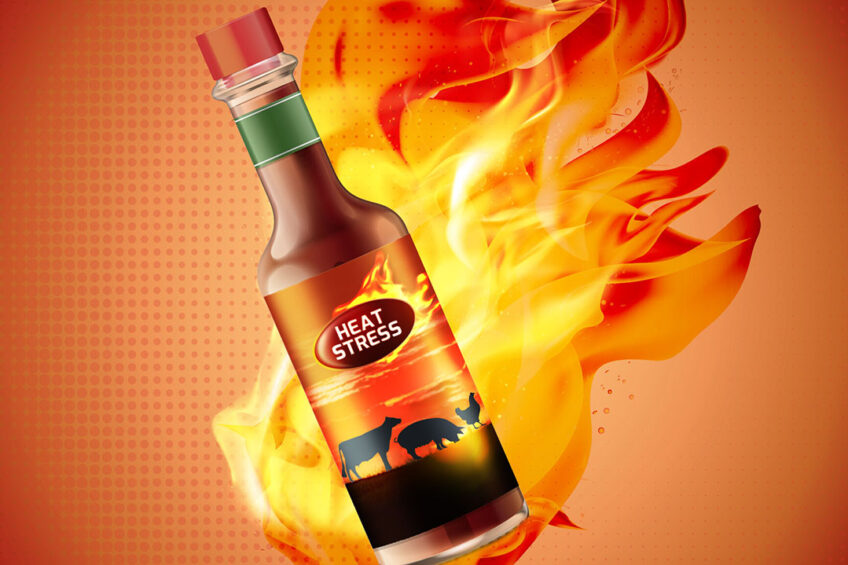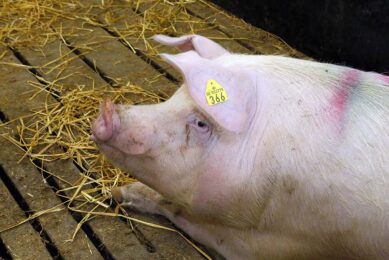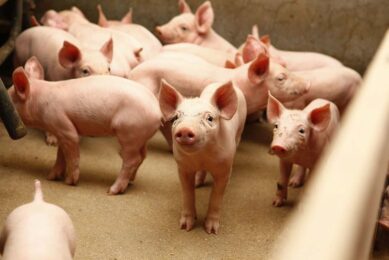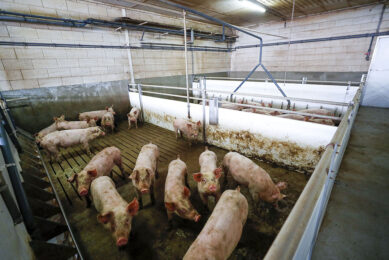Getting to the heat of the matter!

Heat stress is responsible for large economic losses in animal production around the world. Producers can play a part in help mitigating the negative effects of heat stress through nutritional solutions.
Animal production in hot conditions is a major challenge in many regions and has been forecast to become more widespread in the future. During heat stress, several adaptive strategies are used to dissipate excess heat. Firstly, when high temperatures occur, water consumption increases, and feed intake decreases (thus reducing nutrient uptake). Secondly, in the attempt to dissipate heat, livestock increase heart and respiration rates. Metabolism is severely impacted, often resulting in oxidative stress.
Improving antioxidant status
During heat stress conditions it has been shown that supplementing diets with antioxidants can help to prevent any detrimental effects. At a cellular level, metabolic changes that occur during heat stress induce an overproduction of free radicals; the cell needs to be protected by antioxidants to counteract this. Selenium plays a key role in antioxidant defence; however, the form of selenium is important. OH-SeMet has a high level of bioavailability and regulates specific selenoproteins. During heat stress OH-SeMet supplementation can increase antioxidant status, cell-mediated immunity and selenium storage in tissues – to a greater extent than other forms of selenium.
Supporting metabolism
Methionine is an essential amino acid for protein synthesis and downstream metabolites actively participate in antioxidant defences. Methionine in the form of HMTBA has been shown to be more efficient than other sources during heat stress. As it is a better supplier of cysteine, glutathione and taurine than L-Met or DL-Met. HMTBA helps protect muscle by reducing the negative influence of heat stress on growth and meat quality. Heat stress causes an increased amount of fat at the expense of lean tissue, due to its effect on nutrient partitioning. It has been demonstrated that supplementing with HMTBA has a positive impact on performance, oxidative stress and lipogenesis.
Optimising feed intake
One of the key effects of heat stress is a reduction in feed intake, with sows particularly affected by nutritional deficiencies. If a palatability enhancer is used, both the average daily feed intake of the sow and the growth rate of her piglets can be improved. Optimising ADFI allows sows to drive nutrients and energy to the mammary gland – maximising milk production for their litters. As a result, piglets show improved growth, with bigger and heavier litters weaned. Ruminants also benefit from palatability enhancers during heat stress, in the same way.
RUMINANT SOLUTIONS
Cattle have difficulty in dissipating their heat loads efficiently, as they do not sweat and rely on respiration to cool down. The fermentation process that takes place in the rumen generates additional heat, accumulating during the day, it is then dissipated at night when it is cooler. When the environment at night is insufficiently cool, the animal accumulates heat that it cannot release, resulting in heat stress. Heat stress affects the health and welfare of herds, as well as performance leading to economic losses. High temperatures have a direct and negative effect on milk yield, due to a decrease in feed intake. Trials with the palatability enhancer Gusti Plus have recorded increases in dry matter intake and daily milk yield. In a trial comparing the performance of heat stressed dairy cattle supplemented with OH-SeMet (Selisseo) or sodium selenite (SS); milk yield tended to be higher in cows fed OH-Se Met (Figure 1).
POULTRY SOLUTIONS
Heat stress has negative effects on broiler production in terms of ADG, feed efficiency, liveability, meat yield and quality. For laying hens, egg production and quality are also reduced, whilst in breeding birds, fertility and hatchability are affected. Methionine in the form of HMTBA, through its higher trans-sulphuration potential and glutathione production, improves redox status and is complementary to the antioxidant properties of OH-SeMet helping poultry to better cope with heat stress.
Evidence in broilers
The effect of OH-SeMet supplementation on growth performance of broilers exposed to heat stress have been evaluated in several trials using different broiler genetics and under various heat stress conditions. In those trials, compared to sodium selenite, OH-SeMet improved the antioxidant status of the birds resulting on average in about 30 g final body weight improvement, a 2% lowering in FCR and about 2 point less in mortality rate. A trial in Thailand showed improvement in FCR of those broilers fed HMTBA (Rhodimet). Researchers in Brazil saw a numerical improvement of BWG (+63g) and significantly lowering FCR (0.9 pts) in broilers fed HMTBA (Figure 2).
Figure 2 – HMTBA improved broiler body weight gain and FCR under hot conditions in Brazil.

SWINE SOLUTIONS
Enhancing the palatability of diets improves sow performance and optimises the value of lactation diets. The application of a palatability enhancer (PE) (Krave), in a tropical climate conditions, at 500 g/t, increased ADFI by 29% compared to control group and by 9.6% compared to PE at 250 g/t (Figure 3). Sows fed the higher inclusion level had increased average daily milk production,11% and 51% higher respectively, when compared to the lower level or the negative control group. These improvements resulted in higher daily litter weight gain and weaning litter size. Daily litter weight gain in litters from sows fed 500 g/t PE was 23% and 31% higher compared to 250 g/t and the negative control groups, respectively. This observation is a consequence of the increase in sows’ ADFI and milk production, improving piglet weight gain. Dietary methionine level is also a subject worth exploring in hot conditions. In trials, heat stressed swine fed HMTBA had a greater loin depth, compared to DL-Met.
Support for heat stress
Using palatability enhancers to support feed intake helps ensure the performance of livestock and their offspring. Antioxidant capacity defines the ability of an animal to withstand heat stress. Supplementing animals with OH-SeMet, vitamins E and C – supports this. Using complementary nutritional strategies, including HMTBA, livestock are able to deal with unwanted metabolic consequences. In this way growth, efficiency, fertility, milk production, immunity, meat and egg quality are optimised.
Contact: Adisseo.team@adisseo.com for more information
Author:
Adisseo






